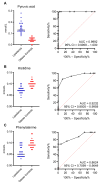Serum Metabolomic Profiling of Patients with Lipedema
- PMID: 38139266
- PMCID: PMC10743543
- DOI: 10.3390/ijms242417437
Serum Metabolomic Profiling of Patients with Lipedema
Abstract
Lipedema is a chronic condition characterized by disproportionate and symmetrical enlargement of adipose tissue, predominantly affecting the lower limbs of women. This study investigated the use of metabolomics in lipedema research, with the objective of identifying complex metabolic disturbances and potential biomarkers for early detection, prognosis, and treatment strategies. The study group (n = 25) comprised women diagnosed with lipedema. The controls were 25 lean women and 25 obese females, both matched for age. In the patients with lipedema, there were notable changes in the metabolite parameters. Specifically, lower levels of histidine and phenylalanine were observed, whereas pyruvic acid was elevated compared with the weight controls. The receiver operating characteristic (ROC) curves for the diagnostic accuracy of histidine, phenylalanine, and pyruvic acid concentrations in distinguishing between patients with lipedema and those with obesity but without lipedema revealed good diagnostic ability for all parameters, with pyruvic acid being the most promising (area under the curve (AUC): 0.9992). Subgroup analysis within matched body mass index (BMI) ranges (30.0 to 39.9 kg/m2) further revealed that differences in pyruvic acid, phenylalanine, and histidine levels are likely linked to lipedema pathology rather than BMI variations. Changes in low-density lipoprotein (LDL)-6 TG levels and significant reductions in various LDL-2-carried lipids of patients with lipedema, compared with the lean controls, were observed. However, these lipids were similar between the lipedema patients and the obese controls, suggesting that these alterations are related to adiposity. Metabolomics is a valuable tool for investigating lipedema, offering a comprehensive view of metabolic changes and insights into lipedema's underlying mechanisms.
Keywords: 1H-NMR; 1H-nuclear magnetic resonance spectroscopy; adipose tissue; lipedema; metabolomics.
Conflict of interest statement
The authors declare no conflict of interest.
Figures






References
-
- Ishaq M., Bandara N., Morgan S., Nowell C., Mehdi A.M., Lyu R., McCarthy D., Anderson D., Creek D.J., Achen M.G., et al. Key signaling networks are dysregulated in patients with the adipose tissue disorder, lipedema. Int. J. Obes. 2022;46:502–514. doi: 10.1038/s41366-021-01002-1. - DOI - PMC - PubMed
-
- Al-Ghadban S., Cromer W., Allen M., Ussery C., Badowski M., Harris D., Herbst K.L. Dilated Blood and Lymphatic Microvessels, Angiogenesis, Increased Macrophages, and Adipocyte Hypertrophy in Lipedema Thigh Skin and Fat Tissue. J. Obes. 2019;2019:8747461. doi: 10.1155/2019/8747461. - DOI - PMC - PubMed
MeSH terms
Substances
LinkOut - more resources
Full Text Sources
Miscellaneous

